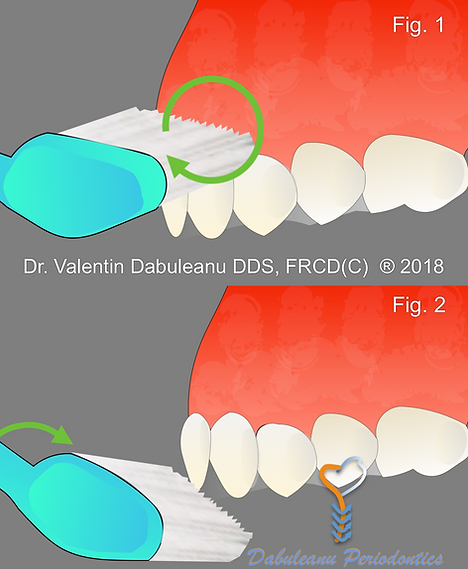Periodontal Conditions
GINGIVITIS
- Visible redness and swelling
- Sensitivity and tenderness
- Bleeding when brushing or flossing
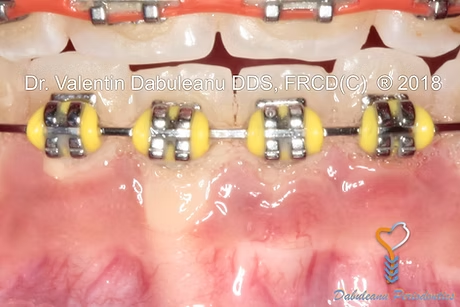
BLEEDING GUMS
The most common cause of bleeding gums is gingivitis, a mild and reversible form of gum disease. If it is left untreated however, gingivitis will progress into periodontitis, which is irreversible destruction of tooth-supporting bone and connective tissue.
Although a proper brushing and flossing technique and frequency is always recommended, the only way to actually find out what is causing your gums to bleed is to see a Periodontist.
SWOLLEN GUMS
Swelling of the gums is a reversible condition. The following are recommended:
- A consultation with a Periodontist: they will put a comprehensive plan together to help treat the condition and prevent if from ever reoccurring
- Practice thorough daily home brushing and flossing
- As a temporary solution before seeing a professional, you can try rinsing your mouth with a ¼ teaspoon of salt in a warm glass of water, to help reduce the discomfort
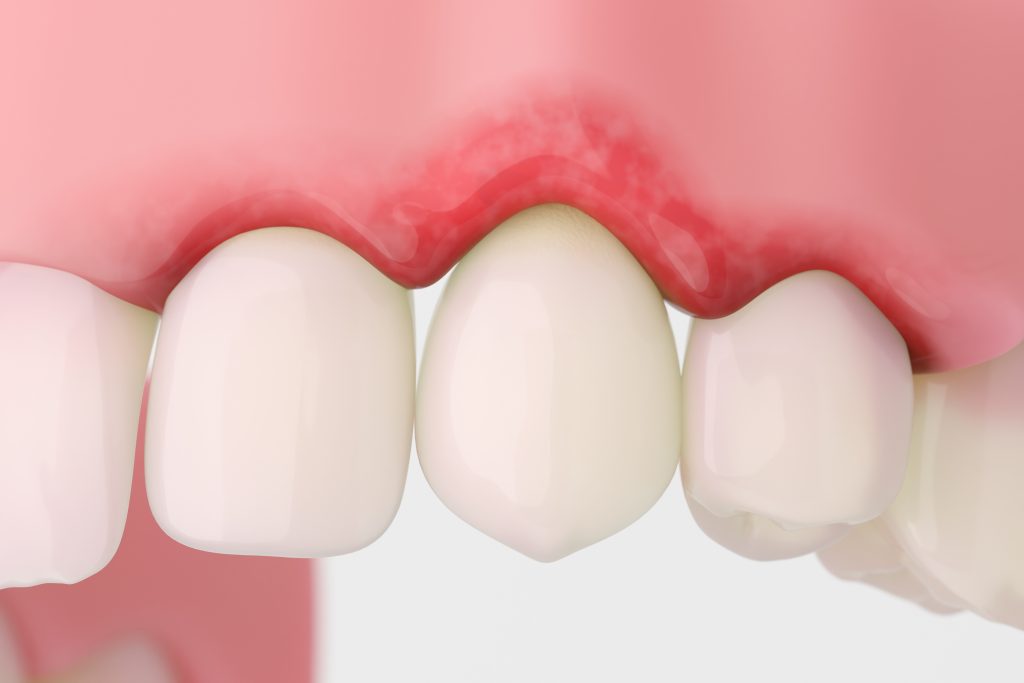
RECEEDING GUMS
Figure 1
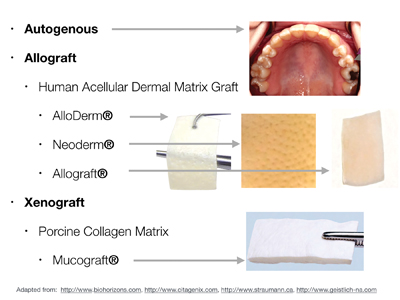
Figure 2
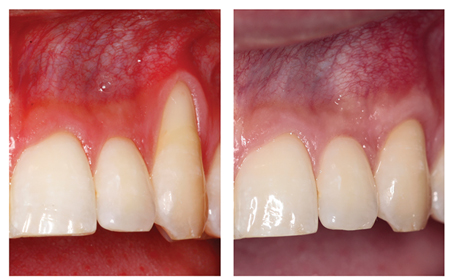
Figure 3
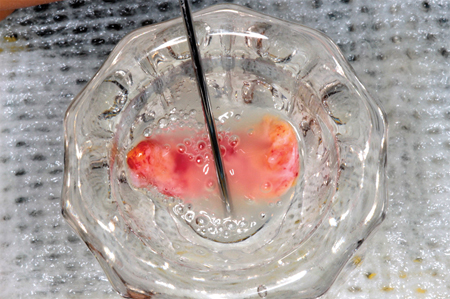
Figure 4
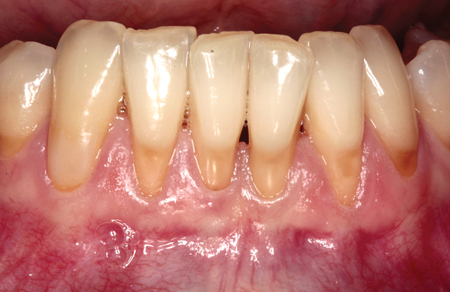
For more information please visit the following online link to an article published in Oral Health, one of our national dental journals, written by Dr. Valentin Dabuleanu
PERIODONTITIS
Periodontitis is a chronic infection that destroys the structure of our tooth support, the gums and bone. If this disease goes on untreated, it may eventually lead to the loss of our teeth. Periodontitis has been associated with diabetes, cardiovascular disease, chronic obstructive pulmonary disease (COPD) and pneumonia. The quicker a Periodontist can detect it, the quicker they can refer patients to their physicians for general assessment, and provide periodontal treatment to help resolve the condition.

Some signs and symptoms associated with periodontitis include:
- Red or purplish gums
- Receding gums
- Bleeding when brushing or flossing
- Teeth that feel loose
- Shifting teeth
- Bad breath
BAD BREATH
Bad breath can be prevented through a combination of the following:
- A thorough daily home brushing and flossing regimen, including the use of a tongue cleaner
- Regular dental checkups and cleanings
- Consultation with a Periodontist to help rule out periodontitis
- A healthy daily consumption of water to make sure your mouth produces enough saliva
THE MOUTH-BODY RELATIONSHIP
Periodontics is one of the most heavily researched disciplines in dentistry. The American Academy of Periodontology (AAP) has produced a series of clinical and scientific papers which summarize their statements, positions, parameters of care, and reviews on important topics in periodontics (Link to AAP). Periodontology 2000 is a well-recognized periodontal journal that produces in-depth review articles on every topic within the periodontal specialty (Link to Periodontology 2000).
Respiratory Disease
1 in 12, or 8% of Canadian adults 20 years of age or older live with diagnosed heart disease. Coronary artery disease is the most common type of heart disease. Heart disease is the 2nd leading cause of death in the Canada.4 Obtaining treatment for periodontal problems can help prevent us from developing this unfortunate condition. Professional treatment must be combined with proper home oral hygiene techniques and frequency, and regular professional hygiene maintenance visits with a dental hygienist.
Diabetes
Respiratory Disease
Osteoporosis
Pregnancy
References
- Genco R, et al. Risk factors for periodontal disease. Periodontology 2000. 2013; 62: 59-94.
- Leng W, et al. Periodontal disease and risk of coronary heart disease: An updated meta-analysis of prospective cohort studies. International Journal of Cardiology. 2015: 469-472.
- Scannapieco F, et al. Oral inflammation and infection, and chronic medical diseases: implications for the elderly. Periodontology 2000. 2016; 72: 153-175.
- Public Health Agency of Canada. 2017, February 9. Heart Disease in Canada.
- Mealy B, et al. Diabetes Mellitus and Periodontal Diseases. Journal of Periodontology. 2006; 77: 1289-1303.
- Public Health Agency of Canada. 2017, November 14. Diabetes in Canada.
- Zeng X, et al. Periodontal disease and incident lung cancer risk: a meta-analysis of cohort studies. Journal of Periodontology. 2016; 87: 1158-1164.
- Public Health Agency of Canada. 2017, June. Lung cancer in Canada.
- Mau L, et al. Patients with chronic periodontitis present increased risk for osteoporosis: A population-based cohort study in Taiwan. Journal of Periodontal Research. 2017; 52: 922-929.
- Public Health Agency of Canada. 2018, January 12. Osteoporosis.
- Xiong X, et al. Periodontal disease and adverse pregnancy outcomes: a systematic review. British Journal of Obstetrics and Gynaecology. 2006; 113: 135-143.
- Statistics Canada. 2016, October 26. Health Fact Sheets – Preterm live births in Canada, 2000 – 2013.
- Iheozor-Ejiofor Z, et al. Treating periodontal disease for preventing adverse birth outcomes in pregnant women (Review). Cochrane Database of Systematic Reviews. 2017: 1-84.
GENERAL GUM CARE
- Cavities
- Gum disease
Keys to good home oral hygiene care:
- Brush twice daily using a soft bristle toothbrush (see below)
- Floss daily to remove trapped food particles and plaque from between your teeth. Waxed floss is recommended as it is easier to use
- Anti-plaque mouth rinses, approved by the American Dental Association, contain agents that may help to prevent signs of early gum disease from occurring. The key remains brushing and flossing however
- Avoid sugary and starchy foods that can create unwanted acidity. This will help to prevent cavities
- Visit your dentist twice a year for regular cleanings and checkups
BRUSHING TECHNIQUE
Brush twice daily using a soft bristle toothbrush. Use the Modified Bass brushing technique (Link to Youtube Video):
- Hold the toothbrush such that the bristles are aimed at a 45 degree angle to the tooth and gum line
- Use very small circular strokes to remove plaque. Imagine that you are “wiggling” away to get the bristles down between the teeth and under the gum line (Figure 1)
- Slowly move across all the teeth and repeat the circular strokes
- As you return back to the first tooth, roll the head of the brush down and away from your teeth (Figure 2)
